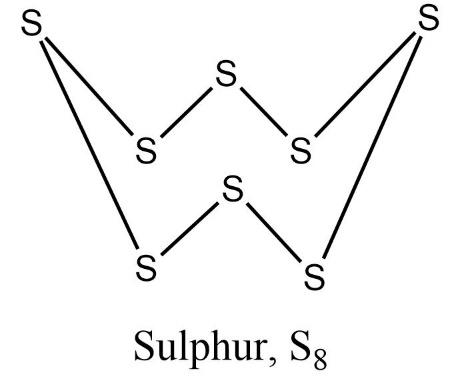
Molecular formula of oxygen is ${{O}_{2}}$ while sulphur is ${{S}_{8}}$, why ?
Answer
579.9k+ views
Hint: Write the electronic configuration of oxygen and sulphur. Think about what happens to atomic size when you go down the group. Also, think about physical states of oxygen and sulphur.
Complete step by step answer:
- Oxygen and sulphur belongs to the Group 16 family of chalcogens. Oxygen has the electronic configuration as follows,
${}^{8}O=1{{s}^{2}}2{{s}^{2}}2{{p}^{4}}$
- Oxygen is a gas while all other chalcogens are solids at room temperature.
- Oxygen has the potential to form a $p\pi -p\pi $ bond. This $p\pi -p\pi $ overlapping between two oxygen atoms leads to the formation of a diatomic stable ${{O}_{2}}$ molecule having a linear structure (O=O). Moreover, these ${{O}_{2}}$ molecules have only weak Van der Waals’ forces of interaction between them and so it exists in a gaseous state.
- Now, let’s have a look at sulphur.
The electronic configuration of sulphur is,
\[{{S}_{2}}=1{{s}^{2}}2{{s}^{2}}2{{p}^{6}}3{{s}^{2}}3{{p}^{4}}\]
- As we move down the group, atomic size increases due to addition of a greater number of orbitals. Due to the large size of sulphur and also the presence of vacant 3d orbitals, sulphur is not able to form $p\pi -p\pi $ bonds.
- The p-orbitals of adjacent sulphur overlap axially only giving rise to $\text{ }\!\!\sigma\!\!\text{ -bonds}$. But one atom of sulphur needs to form at least two such bonds to attain noble gas configuration. Similarly, each sulphur needs to form a stable configuration. This can only be achieved by formation of a cyclic ring.
So, eight sulphur atoms join together to form a polyatomic crown shaped puckered ring.

Therefore, we can justify that, the molecular formula of oxygen is ${{O}_{2}}$ while sulphur is ${{S}_{8}}$.
Note: Like sulphur, selenium also forms a puckered ring structure. Also, polyatomic molecules have strong Van der Waals’ forces of interaction between them and so they exist as solids at room temperature. Remember atomic radii increases down the group and decreases as we move from left to right in the periodic table.
Complete step by step answer:
- Oxygen and sulphur belongs to the Group 16 family of chalcogens. Oxygen has the electronic configuration as follows,
${}^{8}O=1{{s}^{2}}2{{s}^{2}}2{{p}^{4}}$
- Oxygen is a gas while all other chalcogens are solids at room temperature.
- Oxygen has the potential to form a $p\pi -p\pi $ bond. This $p\pi -p\pi $ overlapping between two oxygen atoms leads to the formation of a diatomic stable ${{O}_{2}}$ molecule having a linear structure (O=O). Moreover, these ${{O}_{2}}$ molecules have only weak Van der Waals’ forces of interaction between them and so it exists in a gaseous state.
- Now, let’s have a look at sulphur.
The electronic configuration of sulphur is,
\[{{S}_{2}}=1{{s}^{2}}2{{s}^{2}}2{{p}^{6}}3{{s}^{2}}3{{p}^{4}}\]
- As we move down the group, atomic size increases due to addition of a greater number of orbitals. Due to the large size of sulphur and also the presence of vacant 3d orbitals, sulphur is not able to form $p\pi -p\pi $ bonds.
- The p-orbitals of adjacent sulphur overlap axially only giving rise to $\text{ }\!\!\sigma\!\!\text{ -bonds}$. But one atom of sulphur needs to form at least two such bonds to attain noble gas configuration. Similarly, each sulphur needs to form a stable configuration. This can only be achieved by formation of a cyclic ring.
So, eight sulphur atoms join together to form a polyatomic crown shaped puckered ring.

Therefore, we can justify that, the molecular formula of oxygen is ${{O}_{2}}$ while sulphur is ${{S}_{8}}$.
Note: Like sulphur, selenium also forms a puckered ring structure. Also, polyatomic molecules have strong Van der Waals’ forces of interaction between them and so they exist as solids at room temperature. Remember atomic radii increases down the group and decreases as we move from left to right in the periodic table.
Recently Updated Pages
Why are manures considered better than fertilizers class 11 biology CBSE

Find the coordinates of the midpoint of the line segment class 11 maths CBSE

Distinguish between static friction limiting friction class 11 physics CBSE

The Chairman of the constituent Assembly was A Jawaharlal class 11 social science CBSE

The first National Commission on Labour NCL submitted class 11 social science CBSE

Number of all subshell of n + l 7 is A 4 B 5 C 6 D class 11 chemistry CBSE

Trending doubts
10 examples of friction in our daily life

One Metric ton is equal to kg A 10000 B 1000 C 100 class 11 physics CBSE

Difference Between Prokaryotic Cells and Eukaryotic Cells

1 Quintal is equal to a 110 kg b 10 kg c 100kg d 1000 class 11 physics CBSE

State the laws of reflection of light

Explain zero factorial class 11 maths CBSE




